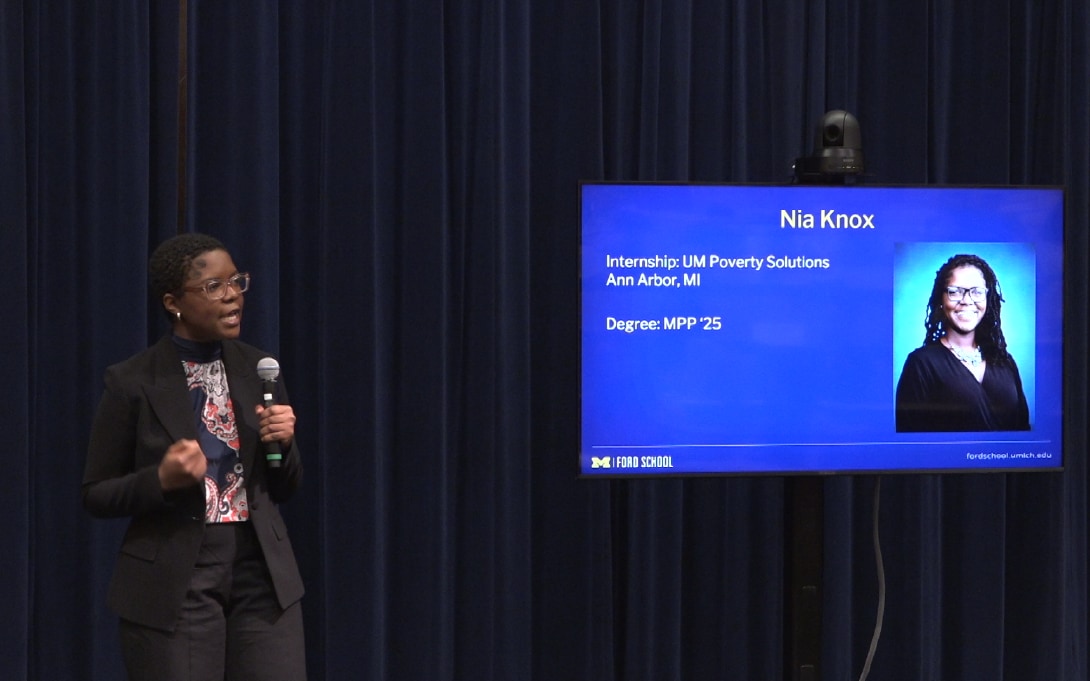
Eleven talented students showcased what they learned during their summer internship at the Ford School 7th Annual Policy Pitch Competition. Undergraduate and graduate students spent three minutes sharing their key deliverables, policy impacts, and lessons learned with the chance to compete for 1st, 2nd, and 3rd student prizes.
The panel of judges awarded students based on the clarity and effectiveness of the presentation, the potential policy impact of their work, and how it influenced the student’s long-term goals. Judges included: Yousef Rabhi, Washtenaw County Commissioner, Rohan Dharan (BA’13), Manager of Secondary Advanced and Enriched Instruction at District of Columbia Public Schools, and Latesha Love-Grayer (MPP’02), Director of International Affairs and Trade at US Government Accountability Office.
Nia Knox (MPP ‘25) – UM Poverty Solutions
Good evening everyone. We all know there’s a long-standing opioid crisis in this country. But is it getting better or worse? What about in Michigan, specifically, and also exactly who is the most impacted? My name is Nia Knox and I'm a second year MPP student at the Ford School, and those are the exact questions that I and John Boulat, my supervisor, at my summer internship at Poverty Solutions partnered to try and answer.
One of my summer projects was the creation of an asset map. An asset map is a data visualization tool that highlights the resources within a community. Our interest in developing this asset map was inspired by a sobering finding.
Although the overall opioid overdose death rates in Michigan are declining, certain demographic subgroups like the Bay County Area and young black men in Michigan weren’t seeing similar downward trends. In developing this asset map, John and I sought to empower decision makers to tailor their interventions towards addressing these disproportionate harms.
A key takeaway from this work was this: The reciprocal relationships that hospitals create with treatment providers, while streamlined on the administration side, might not always meet the needs of the locales being served. I suggested leveraging community care networks and their intimate knowledge of their own communities, to coordinate connections to care that might better serve their needs. And the funding for this likely already exists. States like Michigan can apply for a demonstration waiver, a federal initiative that would help community care networks facilitate greater community support.
In closing, this work with poverty solutions gave me a solid foundation in the mapping and research necessary to scope social problems as well as highlighted the importance of integrating community voices and needs into informed policy. When we talk about evidence-based policy and data analysis, it’s important to remember that behind each data point is a person with a story that deserves to be centered. I study public policy because improving social well-being, especially for marginalized groups, is work inherently related to building up communities. This is the very dimension that I wish to stake my career in, and so, I’m very thankful for an experience that strengthened my conviction in the career path that I would like to take.
Thank you.
Read the other pitches:
Georgina Bailey – Lansing Board of Water & Light
Bridget Corwin – Great Lakes Renewable Energy Association
Audrey Dombro – City of Philadelphia, Office of Transportation and Infrastructure Systems
Nia Knox – UM Poverty Solutions
Emily Kuttner – City of Chicago, Mayor's Office
Alexie Milukhin – The Institute for College Access and Success (TICAS)
Samuel Owusu – U.S. House of Representatives, Committee on Education & the Workforce
Aiswarya Padmanabhan – Trust for Social Achievement
Katrina Wheelan – City of Detroit, Office of Budget